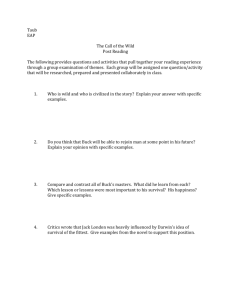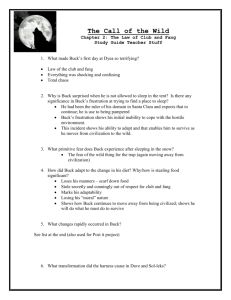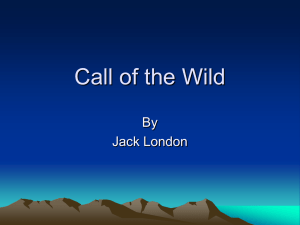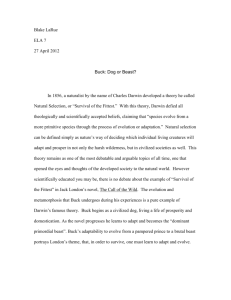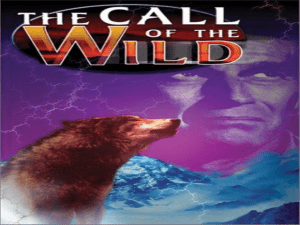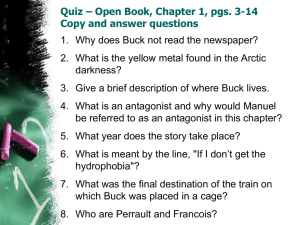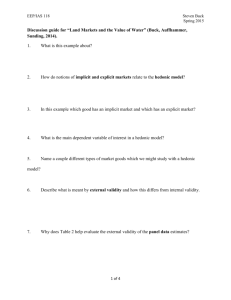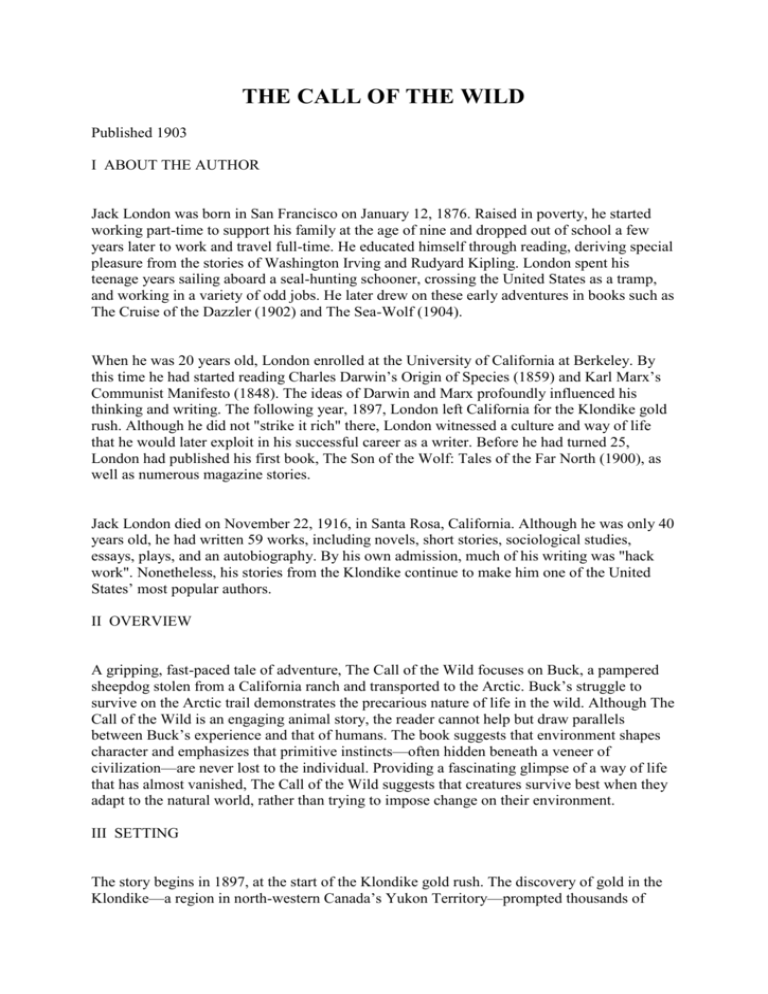
THE CALL OF THE WILD
Published 1903
I ABOUT THE AUTHOR
Jack London was born in San Francisco on January 12, 1876. Raised in poverty, he started
working part-time to support his family at the age of nine and dropped out of school a few
years later to work and travel full-time. He educated himself through reading, deriving special
pleasure from the stories of Washington Irving and Rudyard Kipling. London spent his
teenage years sailing aboard a seal-hunting schooner, crossing the United States as a tramp,
and working in a variety of odd jobs. He later drew on these early adventures in books such as
The Cruise of the Dazzler (1902) and The Sea-Wolf (1904).
When he was 20 years old, London enrolled at the University of California at Berkeley. By
this time he had started reading Charles Darwin’s Origin of Species (1859) and Karl Marx’s
Communist Manifesto (1848). The ideas of Darwin and Marx profoundly influenced his
thinking and writing. The following year, 1897, London left California for the Klondike gold
rush. Although he did not "strike it rich" there, London witnessed a culture and way of life
that he would later exploit in his successful career as a writer. Before he had turned 25,
London had published his first book, The Son of the Wolf: Tales of the Far North (1900), as
well as numerous magazine stories.
Jack London died on November 22, 1916, in Santa Rosa, California. Although he was only 40
years old, he had written 59 works, including novels, short stories, sociological studies,
essays, plays, and an autobiography. By his own admission, much of his writing was "hack
work". Nonetheless, his stories from the Klondike continue to make him one of the United
States’ most popular authors.
II OVERVIEW
A gripping, fast-paced tale of adventure, The Call of the Wild focuses on Buck, a pampered
sheepdog stolen from a California ranch and transported to the Arctic. Buck’s struggle to
survive on the Arctic trail demonstrates the precarious nature of life in the wild. Although The
Call of the Wild is an engaging animal story, the reader cannot help but draw parallels
between Buck’s experience and that of humans. The book suggests that environment shapes
character and emphasizes that primitive instincts—often hidden beneath a veneer of
civilization—are never lost to the individual. Providing a fascinating glimpse of a way of life
that has almost vanished, The Call of the Wild suggests that creatures survive best when they
adapt to the natural world, rather than trying to impose change on their environment.
III SETTING
The story begins in 1897, at the start of the Klondike gold rush. The discovery of gold in the
Klondike—a region in north-western Canada’s Yukon Territory—prompted thousands of
gold-seekers to head for the far north, all of them desperately in need of dogs to pull sledges
across the harsh Arctic trails. Buck, a large dog who has enjoyed a leisurely life on a
California ranch, is stolen and shipped to the Yukon. Buck learns to survive in this cruel
environment; he begins to rediscover the primitive instincts of his ancestors and in time he
responds to the call of the wild.
IV THEMES AND CHARACTERS
Human characters are of secondary importance in The Call of the Wild as the novel focuses
on Buck’s experience. Buck is a magnificent dog, part Scottish Shepherd and part St Bernard.
His superior strength enables him to adapt readily to the northern climate and the harsh
demands of his labours. But he possesses one additional quality—imagination. Buck fights
with his brain as well as his brawn.
Adaptability is a dominant theme in The Call of the Wild. In order to survive in the Yukon,
Buck must learn "the law of club and fang". Buck is first taught this law by the club-wielding
sledge drivers François and Perrault, who show him that the strongest individuals are those
who rule. Buck also learns this primitive law from the other team dogs, such as Dave, Solleks, and the vicious team leader, Spitz. From them, Buck learns that he must either bite or be
bitten, master or be mastered. The ferocity of the dogs is described vividly and powerfully, as
London shows "the law of club and fang" in brutal operation.
The theme of adaptability, or "survival of the fittest", is a popular Darwinian concept that
appears in many of London’s stories, applying to humans as well as to animals. In contrast to
François and Perrault, who know how to survive in the harsh Arctic environment, the
incompetent miners Charles, Hal, and Mercedes are unable to adapt to their surroundings. The
trio lacks discipline, skill, imagination, and self-control. They attempt to use 14 dogs instead
of 9, not considering that their sledge cannot carry food for so many dogs. They also insist on
unnecessary luxuries, which only serve to burden them further and lead to their inevitable
downfall.
When John Thornton befriends Buck and saves his life, London introduces another theme that
is popular in animal stories—the love and loyalty between human and beast. In The Call of
the Wild, the bond between Buck and John Thornton is especially important, because their
mutual survival depends upon it. When Thornton is murdered by the Yeehats, a group of
Native Americans, Buck avenges the death by killing Thornton’s murderers. In doing so, he
discovers just how vulnerable humans are.
John Thornton is portrayed as a kind and fair man, making his unexplained murder by the
Yeehats all the more shocking. The murder serves as an illustration of how human beings can
act just as savagely as animals. Buck’s bloodthirsty revenge on the Yeehats is extreme,
opening up questions about the nature of justice and retribution, and the values of civilization.
Buck’s retrogression, which culminates in his transformation into the leader of a wolf pack, is
probably the most provocative theme of the book. It reflects London’s belief that environment
determines character. Away from the ease of civilized life, Buck must rely increasingly on his
survival instincts. Under the harsh conditions in the wilderness, he develops certain primal
traits: he becomes more cunning, deliberate, and calculating. He learns how to kill mercilessly
and to show no sign of weakness.
As Buck adapts to life in the wild, he begins to experience primordial visions, to imagine life
in some earlier, more primitive age. He dreams of savage beasts and a hairy man crouching
beside a fire. He hears the howl of the wolves and instinctively responds; he becomes
increasingly restless and begins to wander into the forest. After the death of John Thornton,
Buck answers the call of the wild and takes up the life of his ancestors.
V LITERARY TECHNIQUE
The Call of the Wild is typical of the school of literary Naturalism that developed at the turn
of the 20th century: the story is presented realistically and directly, and dramatizes the force
of environment in shaping character. The Call of the Wild is widely acclaimed as London’s
best work of fiction. The author’s firm control of plot and focused point of view give the story
its coherence. London’s diction is rich, full of complex and mellifluous words. His style is
lean and vigorous, and grows increasingly resonant with mystical overtones near the end of
the book.
An often-cited literary precedent to The Call of the Wild is Frank Norris’s 1899 novel
McTeague. Norris’s work traces the downfall of a San Francisco dentist who destroys himself
and those around him when his alcoholism and violent tendencies erupt. Like Norris, London
explores the hidden character traits, triggered by interaction with one’s environment, that
determine an individual’s fate.
Many readers have interpreted Buck’s struggles as an allegory of human experience. Some
see The Call of the Wild as a fable, for, like Aesop’s fables, the novel tells the story of an
animal who triumphs through strength and cunning. Other readers, like critic Earle Labor,
describe Buck as a mythic hero who sets out on a perilous adventure, journeys to a
mysterious, faraway place, and is thoroughly transformed.
VI TOPICS FOR DISCUSSION
Compare Buck’s life on the ranch with his life in the wild. Which is better for Buck? And
why?
What qualities does Buck have that make him superior to the other dogs? What qualities make
him an effective leader?
What is "the law of club and fang", and how does it operate?
Why are Hal, Charles, and Mercedes unable to survive on the trail? Explain several different
causes for their failure.
Buck begins to dream of a ragged, hairy man crouching before a fire. Where do these dreams
come from? What do they mean?
Trace the stages in Buck’s retrogression, noting the chief factors responsible for his change.
Jack London uses such words as "primordial", "inexorable", "carnivorous", and "wraith" to
describe Buck. What do these words mean and how effectively do they characterize Buck?
How does Buck’s attitude towards human beings progressively change as a result of his
experiences?
Explain how Buck eventually becomes part of Yeehat legend.
What can you learn about the skill of dog-sledging from reading The Call of the Wild? What
skills are necessary for survival on the trail?
VII QUESTIONS
London’s book White Fang tells the story of a wild dog who becomes tamed. Compare and
contrast White Fang to The Call of the Wild.
Write an essay on the Klondike gold rush of 1897. Explain how this gold rush differed from
the California gold rush of 1849.
Robert Service was a popular poet who wrote ballads about the Yukon at the same time as
Jack London was writing his essays and fiction. Read some of Service’s poems and compare
the attitudes of the two writers towards the Arctic wilderness.
For centuries, Eskimos [Inuit] in Alaska and the Yukon have learned to adapt to their
environment. Research their lifestyles. How has their environment and their way of life been
threatened by modern civilization?
William Golding’s novel The Lord of the Flies (1954) is another story about retrogression in a
wild environment. Read Golding’s novel. Do you find it more pessimistic than The Call of the
Wild or more optimistic? Why?
VIII RELATED TITLES AND ADAPTATIONS
London intended his novel White Fang to serve as a sequel and "companion-book" to The
Call of the Wild. An optimistic book, it reverses the direction of Buck’s development: White
Fang is born in the wild and becomes domesticated.
The Call of the Wild has been adapted for the cinema several times. A 1923 film directed by
Hal Roach starred Jack Mulhall; William Wellman directed Clark Gable and Loretta Young in
a 1935 Hollywood version; and, in 1972, Charlton Heston and Michele Mercier starred in an
adaptation directed by Ken Annakin.
Source: Beacham’s Guide to Literature for Young Adults. Copyright by Gale Group, Inc.
Reprinted by permission.
Microsoft ® Encarta ® Premium Suite 2005. © 1993-2004 Microsoft Corporation. All rights
reserved.

